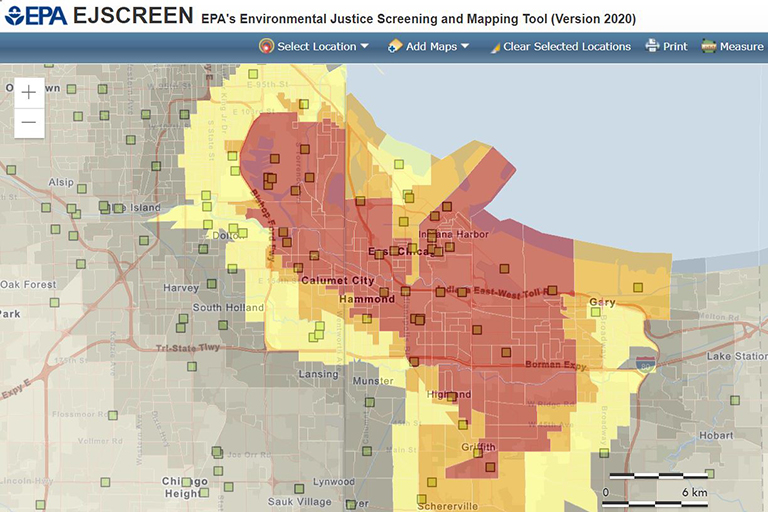As part of an effort to evaluate how Hoosiers might benefit from a mapping tool that highlights Indiana communities overburdened by pollution, a team of Indiana University researchers recently conducted a review of federal and state environmental justice mapping tools used across the country.
The project, led by researchers from IU's O'Neill School of Public and Environmental Affairs and Environmental Resilience Institute (ERI) and funded by IU's Racial Justice Research Fund, is the first step toward creating an environmental justice mapping tool for Indiana.
"What we've learned is that it could be quite valuable for Indiana to have a tool like this," said O'Neill Professor David Konisky, who led the study. "We think it could help government officials at the state and local levels, the public, researchers, and advocacy groups to get a better understanding of where environmental justice communities are in the state and the connections between race, ethnicity, poverty, and environmental and health burdens."
Indiana consistently ranks as one of the most polluted states in the country in terms of air and water quality and leads the nation in toxic releases per square mile, according to a recent US Environmental Protection Agency (EPA) report. Much of that pollution is concentrated in low-income communities and communities of color that face a lower quality of life and worse health outcomes than the rest of the state as a result.
In recent years, federal and state agencies, universities, and non-profit organizations have created public mapping tools to help identify overburdened communities in the US and inform public discourse and policy aimed at addressing longstanding environmental and health inequities.
The idea to conduct a review of existing mapping tools emerged from a collaboration between Konisky and former ERI Director Janet McCabe, who co-led the effort until being appointed to serve as the EPA deputy administrator in April 2021. In addition to Konisky and McCabe, the team included O'Neill Masters in Public Administration candidates Daniel Gonzalez and Kelly Leatherman.
The research team reviewed 19 online tools, including EPA’s national-level EJSCREEN and state-level tools in California, Michigan, New York, and elsewhere. The tools commonly combine geospatial data with demographic, environmental, and health information to shine a spotlight on communities subjected to environmental contamination.
The team found that no two tools are exactly the same, however. Mapping tools differ in their level of interactivity, the data they incorporate, and how information is presented to the user. These design choices result in tools that vary in their complexity as well as their accessibility for the non-expert user.
“Some states only provide demographic information, while others combine that with environmental and health indicators,” Konisky said. “The tools that combine these datasets are really powerful because they allow users to put this information together in an accessible way, and that’s at the heart of what environmental justice is about. It can be a bit of a tradeoff though because a flexible tool requires the user to have a good understanding of the underlying data to make insights.”
Differences between the tools oftentimes stem from how states went about developing and implementing them. For example, states that prioritized public engagement early in the development process seemed to be the most comprehensive and well used, Konisky said.
“It’s really important that these maps are closely aligned with how communities view themselves,” he said. “What that means in practice is having community involvement from the outset.”
Read more about the project
About the Environmental Resilience Institute
Indiana University's Environmental Resilience Institute brings together a coalition of university scholars and leaders in the government, business, nonprofit, and community sectors to help Indiana better prepare for the challenges that environmental changes bring to Hoosiers' economy, health and livelihood.
About the O’Neill School of Public and Environmental Affairs
The O’Neill School is a world leader in public and environmental affairs and is the largest school of public administration and public policy in the United States. In the 2021 "Best Graduate Public Affairs Programs" by U.S. News & World Report, the O'Neill School ranks first in the country. Four of its specialty programs are ranked in the top-five listings, including nonprofit management, ranked first.
IU Research
Indiana University's world-class researchers have driven innovation and creative initiatives that matter for 200 years. From curing testicular cancer to collaborating with NASA to search for life on Mars, IU has earned its reputation as a world-class research institution. Supported by $854 million last year from our partners, IU researchers are building collaborations and uncovering new solutions that improve lives in Indiana and around the globe.




